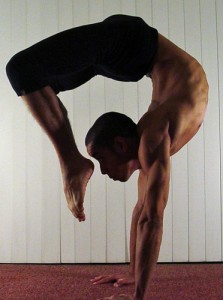Unfortunately for many students, yoga and lower back pain go hand in hand. This happens for any number of reasons that have nothing to do with yoga. One reason this happens is because of the patterns that people bring with them into the yoga room .
Tadasana is not a backbend but every time I look at a group of students standing at the front of their mats during yoga class, I see people in a leaning slightly into a poorly executed backbend. Most students are pushing their thighs forward and leaning the upper body backwards slightly, not to mention locking their shoulders back too far.
A lot of lower back pain arises from the way we stand in tadasana—which is usually a mirror of how we stand in life.
The pain associated with yoga injuries and lower back pain is often related to posture and muscle tone. There are also genetic and structural reasons for back pain but even those conditions are well served by better posture and balanced muscle tone.
This habitual leaning backwards can compress our spines in a debilitating way, no matter how slight the compression. The majority of people I come into contact with have tight lower back muscles and weak or imbalanced abdominal muscles. This imbalance in the length and strength of the lower back and lower belly causes, or exacerbates, lower back pain in our culture.
When we bring this pattern into our yoga practice it is difficult to heal current lower back pain or do much to stave off future injury. Everything about a good asana yoga practice is about finding our way to tadasana through each pose and if we begin with a tadasana that misses the mark it is hard to find the intrinsic healing qualities of the asana practice.
This wasn’t meant to be a post about inversions but I see this lower back compression so often when I am teaching inversions such as hand and forearm stand. I think they illustrate the weaknesses and difficulty many students have with the practice.
I think it is easy and important to define a backbend—a successful backbend is when the muscles along the back of the spine lengthen regardless of the asana (bow, wheel, shalabasana). In a backbend poorly executed the muscles along the spine shorten instead of lengthen. When we stand in tadasana the muscles of the lower back and lower belly should be both balanced in length and tone.
Handstand, adho mukha vrksasana, is not a backbend. It is meant to be an upside down tadasana. Vrschikasana II (the middle picture above) is a different pose—it is turning your handstand into a backbend. There is a similar thing going on with headstands and forearm stands. The essential poses are not meant to be backbends but there are backbending variations for each.
The banana that most people end up in when learning inversions has as much to do with the shoulders as with the core, but it is hard to hide the lack of core balance when you are upside down. The lower back should be lengthening as the lower belly shortens when upside down in any of the inversions.
The inability to get into this tadasana posture in inversions highlights the muscle weakness that is responsible for leaning backwards and compressing the spine while standing. Using yoga to heal lower back pain is a great project but it is important to be aware of exactly what you need to do to make sure your lower back pain goes away forever.
***



